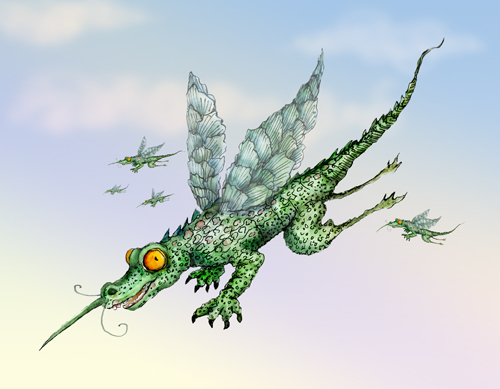Crocsquito apocalypse!

Havoc reigns at Florida tourist resorts as swarms of genetically-engineered mosquito-crocodile hybrids descend upon beaches and golf courses to feed on hapless vacationers.
News Flash! Genetically engineered mosquitoes created by British scientists to combat viral diseases mutate into toothy flying killing machines.
Well, it seemed like a good idea in theory. A British biotech firm with ties to Oxford University developed a methodology to breed mosquitoes whose DNA had been altered using genes from coral and cabbage and proteins from E. Coli bacteria and herpes virus. The thinking was that this combination would suppress breeding because when the altered male mates with a normal female, the resulting larvae will die. This in turn would suppress the incidence of two serious mosquito borne diseases, dengue and chikungunya. To test the effectiveness of the plan, the mosquitoes were released in Key Haven, a secluded development of million-dollar homes near Key West in Florida.
What the scientists did not foresee was a sequence of events that would ultimately lead to calamity as they did not take into account the consequences of introducing a toxic cocktail of genes from animals, plants, bacteria and viruses into the environment. As fate would have it, a freak offshore storm blew in unexpectedly and propelled the GMO mosquitoes off towards the Everglades where they quickly settled in among the foliage. A few stray females that were inadvertently included in the brood began their quest for blood. With no humans in sight, the females proceeded to bite the resident crocodiles. So, what happens when a recombinant DNA experiment involving a mosquito, a crocodile and a cabbage goes awry?
Aedes aegypti + Crocodylus acutus + Brassica oleracea = Crocsquito Apocalypse!!!
It wasn’t long before crocodile hatchlings began to exhibit characteristics of all the genes that had been injected into the GMO altered mosquitoes. They grew long sharp proboscises and stout wings with veined structures similar to cabbage leaves. They soon took to the air seeking nourishment. Attracted by the dazzling display of brightly colored Hawaiian shirts combined with the aroma of thousands of backyard barbecues, the mutants headed straight for Fort Lauderdale to feast on the flesh of terrified tourists.
Even those fortunate enough to escape serious injury from the crocsquito’s sharp crushing jaws, there is still the likelihood of acquiring a nasty case of herpes from the beast’s infectious saliva.
Illustration by Kim Harris
Story by Don Rudisuhle

